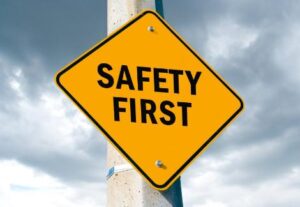Workplace safety is essential for minimizing the potential for legal liabilities and ensuring the safety of  individuals working for a company. A safe and ethical workplace can also make it easier for companies to find clients, who might be attracted by the integrity of a company's internal practices. Below are six critical steps for a plan that can lead to a safer workplace.
individuals working for a company. A safe and ethical workplace can also make it easier for companies to find clients, who might be attracted by the integrity of a company's internal practices. Below are six critical steps for a plan that can lead to a safer workplace.
1. Safety Rules
Rules form the cornerstone of workplace safety. Most companies would find it impossible to maintain safety without fair rules that minimize personnel exposure to danger. Safety rules are important for all companies, including businesses that primarily function out of an office.
Effective safety rules explicitly define behaviors and activities that are strictly off-limits. Safe practices should also be explained carefully in the rules to encourage compliance with best practices. Special rules for safety glasses, hard hats, and other safety equipment should be explained in detail within the rules. Finally, effective safety rules should clearly define a chain of command to prevent contradiction between sources of authority. Safety rules that include all of the above factors can significantly reduce workplace safety risks.
2. Implement a Break Policy
Studies have shown that employees who get into an accident often worked long hours without a break. Extensive periods of work can reduce an individual employee's attention, awareness, and reaction time. Therefore, long working shifts are only safe when routine breaks are given throughout the day. Companies looking to encourage workplace safety should implement a break policy that entitles all employees to receive breaks throughout the day. It is especially important for employees subjected to significant risks to receive breaks at routine intervals. For these reasons, an effective break policy can significantly reduce the potential for workplace injuries.
3. Report Unsafe Conditions
Staff members should be encouraged to report unsafe working conditions that they observe. Rules that encourage the reporting of unsafe conditions can significantly increase the chances of discovering workplace dangers before a problem arises. Unfortunately, many companies implement explicit or implicit policies that discourage employees from reporting workplace hazards. Companies should reward individuals who report hazards in the workplace to increase the incentive for employees to report a problem.
4. Fire Plan
Fires are a critical liability concern for businesses due to the number of individuals who could potentially be harmed by a fire in the workplace. Employees should be taught how to use fire extinguishers to reduce reaction time in the event of a fire emergency. It is also important to keep individuals informed about the location of fire extinguishers within the workplace. The drafting of a fire escape plan is important to reduce confusion during an emergency. Finally, employees should regularly practice the fire escape plan to ensure that everyone is prepared for a fire in the workplace.
5. First Aid
Despite the implementation of preparatory planning, accidents can still happen in the workplace. First aid kits and eye wash stations should be placed throughout a company's facilities to reduce response times when a staff member becomes injured. Companies should prepare their employees for accidents by qualifying a portion of their workforce with first aid skills. Companies should even consider preparing themselves for an injury by pre-arranging a 24-hour nurse triage service to treat severely injured employees.
6. Drug and Alcohol Testing
Drug and alcohol testing can eliminate employees who have a higher risk of unsafe behaviors. Companies should implement policies that screen all new employees for drug abuse. It is also important to regularly conduct testing at random intervals to prevent existing employees from abusing drugs. Employees who experience an accident should also be drug screened to ensure safe reintegration into the workforce.
Latest posts by David Bell (see all)
- What Employers Need To Know About Marijuana Legalization - May 12, 2019
- 6 Steps to a Safer Workplace - May 6, 2015












